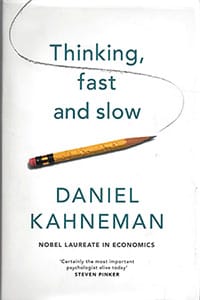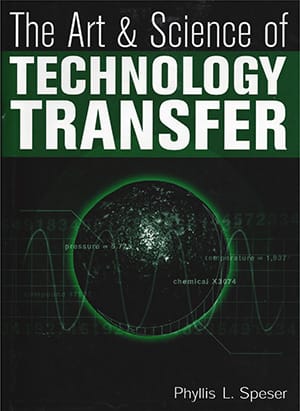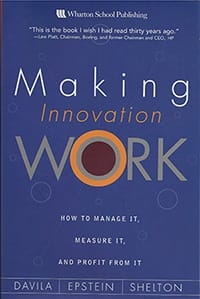-
 Thinking fast and slow
Thinking fast and slowDaniel Kahneman (2011)
The old aphorism, “know thyself”, is at the heart of this intriguing book. By examining the way that people make decisions and what influences decision-making, one can become more aware of one’s own approach to making decisions and, in doing so, be able to make better (or more conscious) decisions. This book deserves to be on the book-shelves of all senior managers.
 The art and science of technology transfer
The art and science of technology transferPhyllis L. Speser (2006)
A useful reminder of many of the issues and pitfalls of taking technology out of the lab and into the market-place. It contains valuable reminders and insights, “Managers at middle or lower levels most often introduced incremental innovations but that radical innovations were typically initiated and developed in units created for this purpose, such as R&D and new ventures”. A useful reference book, although not comprehensive enough to cover everything.
 Making innovation work
Making innovation workTony Davila, Marc J. Epstein, Robert Shelton (2006)
Working out why ‘innovation’ is not working in an organisation can be a challenging task. The authors have summarised their experience and research in this book, which includes some useful check-lists, including the ‘innovation climate diagnostic’ as a way to explore the ‘levers of an innovation culture’ as may exist in the organisation. A useful codification of some innovation analysis tools.
-
Innovation at the interface between industry, academia and government
Introduction
Innovation often involves collaboration between industry, academia and government. One way to expressing this engagement is as a Triple Helix. The Triple Helix Association (http://www.triplehelixassociation.org) is an international organisation that holds annual conferences to share ideas and good practice across the international community. As their web site states, “The Triple Helix Association intends to promote analyses and studies on the interaction between universities, firms and government aimed at translating academic models into practical achievements.”
 In July 2013, the Big Innovation Centre (http://www.biginnovationcentre.com) organised the 2013 Triple Helix Association XI conference in London. Grounded Innovation presented a paper (Technology-enabled innovation strategy – a practitioner’s approach) at this event, which summarised our experience working at the interface between industry, academia and government. The paper is summarised below, and the presentation may be found through this link.
In July 2013, the Big Innovation Centre (http://www.biginnovationcentre.com) organised the 2013 Triple Helix Association XI conference in London. Grounded Innovation presented a paper (Technology-enabled innovation strategy – a practitioner’s approach) at this event, which summarised our experience working at the interface between industry, academia and government. The paper is summarised below, and the presentation may be found through this link.
Abstract
The Triple Helix model for geographical innovation identifies the actors involved. It provides a framework for understanding, but does not provide a model for effective management, and sustainable economic benefit. This paper describes an innovation strategy, drawn from experience, that addresses this weakness.
Summary
The Triple Helix model captures the key actors that contribute to geographical innovation. Government (The State) recognises that it can stimulate innovation and aspires to establishing innovation eco-systems that are self-sustaining and achieve a range of politically and economically beneficial objectives.
Academia has a more challenging task as Triple Helix engagement means that they have to undertake commercial activities outside their core roles of teaching and research. Maintaining the funding for their core work is demanding, and the requirements to meet commercial objectives can be incompatible with their core work. This Third Mission work is important, and the European Commission, in its E3M project, is working to identify ways to measure the Third Mission outputs (these are: Continuing Education, Technology Transfer & Innovation and Social Engagement).
For industry, having a pipeline of new ideas and innovation is important to meet increasingly varied consumer demands. Often, they are aware of what they need to do and how to do it; often-disruptive innovation occurs and successful businesses emerge from nowhere. The Triple Helix model is based on the innovation principle that innovation occurs when serendipitous interactions occur between various actors: a mathematician might be talking to an engineer in the water industry and be able to identify how to improve the accuracy of measuring water flow; a biologist might be talking to an army officer and recognise that military tactics in one scenario mimic the behaviour of colonies she has been studying.
From a Government perspective, these random innovations are not sufficient. An innovation cluster cannot develop around such randomness. There needs to be a more methodical and active approach.
Science rarely makes the transition into the market-place without effort. It requires a vision of what is possible with the science; it requires a vision of who would benefit; it requires a vision of who can make it happen; and it requires effort and energy to make it happen.
An effective innovation strategy requires action.
The key elements for the technology-enabled innovation strategy that we propose
- An effective, sustainable innovation strategy has to have a leader, and has to have a long-term role.
- The leader must be supported by a team of experienced professionals, who have industrial/commercial experience; are experienced innovators; are technologically informed across a range of technologies; and have worked with government and academia. They must also be independent and impartial actors. The presentation provides a quote that describes such a leader (or champion).
- Each strand of the Triple Helix has different competences (in three areas: organisation, skills, and facilities). In each geographical innovation strategy, the competences of each actor need to be understood, and the objectives/agenda of each should be clearly articulated and agreed.
- Professor Robert Cooper identifies five innovation vectors behind bold innovation.
- An innovation strategy.
- A climate, culture, organisation and leadership that fosters true innovation.
- Idea generation process.
- Idea-to-launch process to drive projects to market.
- Building strong business cases to make the right investment decisions.
- An effective geographical innovation strategy takes this model, assesses the competences available within the geography covered, explores opportunities through a range of innovation practices, and mobilises resources to create and implement ideas.
Such an innovation strategy draws on technology and science within the geographical area, seeks to establish sustainable economic growth, and has a focus on markets (and possible partners) across the globe. The objectives of such a technology-enabled innovation strategy are:
- Build on current capabilities within the geographical area, and enhance/develop them.
- Exploit science and technology to create new opportunities in a range of sectors.
- Identify and manage projects that lead to new products, services, and (possibly) organisations that lead to sustainable increased economic growth.
- Identify new capabilities and nurture them as appropriate.
- Improve the ranking of the academic science (e.g. in the EPSRC funding ranking).
- Develop a collaborative IP portfolio as part of an Open Innovation strategy.
- Deliver sustainable economic growth in a range of industry sectors.
- Become an attractive location for innovative organisations that want to share the innovation capabilities within the region.
References:
- An illustration of this model is presented for Wales:
Welsh Model Link - The European E3M project is described on their web site:
European Project Summary Link - Professor Robert Cooper’s Five Vectors of Innovation are described in this paper:
Five Vectors Link - The Big Innovation Centre has had all the papers available on their web site. They have listed papers alphabetically by first author’s surname under the Conference:
www.biginnovationcentre.com - “What is an Innovation Ecosystem?”, Deborah J. Jackson (2011):
Innovation Ecosystem Link - “Innovative India – Insights for the Thinking Manager” Chadha, Radhika and Chadha, Parmit (2007)




